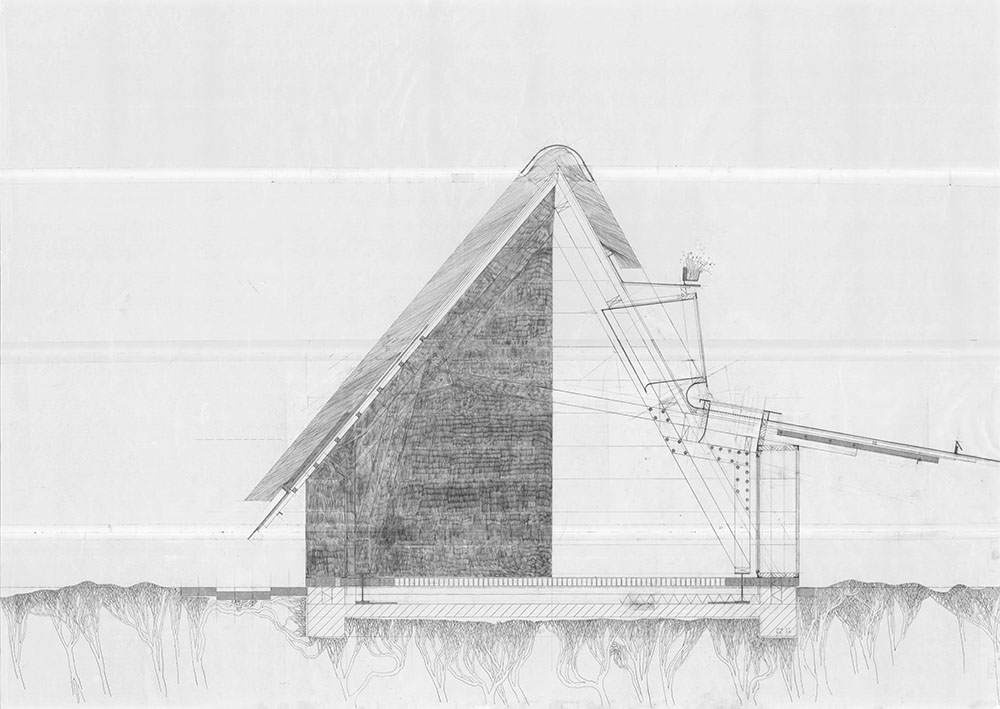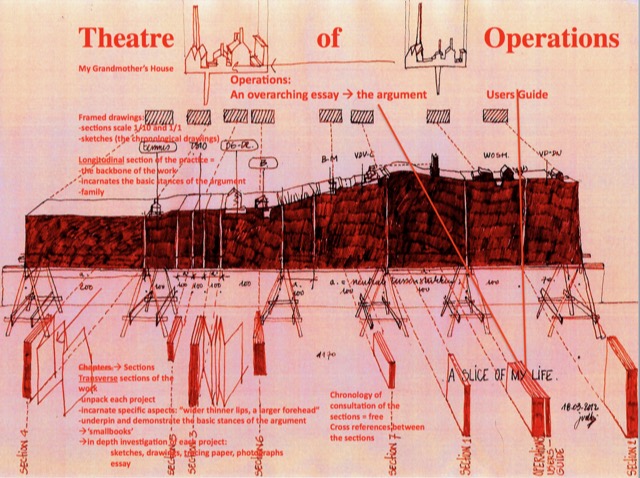| Tutor | Prof.dr. Architect Jo Van Den Berghe |
| Campus | Ghent |
| Language | EN |
| Engagement | Mediating Tactics |
| Semester | 2 |

Description of the studio:
Design a country house in a landscape. A country house for 3 generations: the grandmother, the mother and the daughter. What is shared domesticity? How to conceive architectural intimacy? How to share and to separate individual intimacies? How to imbed this domesticity and these intimacies in the landscape?
Design this country house through drawing its walls and its windows. How can looking into the landscape, from the interiorities of this house—that are the emotional interiorities of its inhabitants—be constitutive for the further development of the rooms of this house? How can a wall emotionally protect and offer a place to hide? How can a window become an eye of a room’s interiority, yet become a room that acts as a loaded/loading interface between the interiority of this house and the landscape it is laid in? How can the provocative window detail—through drawing and redrawing (Critical Sequential Drawing, Van Den Berghe 2021)—become constitutive for the further development of this window-room, yet for a room of the house, and for the emotions that arise from the subconscious of the drawing architect when looking into the landscape from this room through this window?
The studio will operate through two stages.
In the first stage, a thorough reading and study of the topography (landscape) will be done through making vertical topographical sections as drawings and scale models (in the way Renato Rizzi would have done with his students at Università Iuav di Venezia)(Rizzi 2009), in order to anatomize the landscape, and the chosen place in the landscape (point of (p)reference), i.e. ‘the bed’ in which the house will be laid. These sections are meant to be made as ‘lineamenti‘ (Alberti 1452). These ‘lineamenti’ will be lines that precisely situate the topographical profile (at the line of the vertical section), the stylobate, the eye level, the horizon, the contours of the roof. By drawing these lines, the student will draw dialogues between the physical presence of the landscape on the one hand and its impact on the architectural subconscious of the student and the character of the architecture under investigation.
In the second stage, the country house will be designed (cfr. supra), mainly through drawing vertical sections imbedded in the lineamenti as discussed above, in which eventually central perspectives will be further drawn to develop and check the emerging spatial qualities. In these sections, and once the foundations and the stylobate are instituted, it is time to draw a column, a load-bearing wall, and consequently a beam. Gradually, the ceiling, the roof, the roof overhang, the gutter, and the chimney emerge out of this slow but intense process of drawing and redrawing.
Inversely, the drawing architect’s love for a certain column, e.g., a column suggested by Sverre Fehn, or the epiphanic appearance of a Caryatide, can dictate the subsequent conception of a foundation. This studio will strongly bank on the (architectural) reference, urging the student to study his/her favourite architect(s) very deeply, to identify his/her own position regarding drawing, thinking and making architecture.
The country house will be fully investigated and materialized to the level of the full-scale architectural detail.
This detailing will go beyond the merely normative, to liberate the young architect from the censorship that pervades architectural practice and discourse these days (e.g. energy requirements), sometimes dictated by lobbyists, and executed by meek decision makers, at the risk of exiling architecture into stagnation.
This studio is hands-on and focuses strongly on materialization and material thinking in architecture, hence on the knowledge and the skills of the drawing and building architect. The mastery of Technè is the conditio sine qua non for the emergence of Poiesis in architecture, yet Poiesis is what we aim for. However, in this studio, it is assumed that architecture dwells in the drawing. Hence, drawing constitutes the core of the method of the studio. Drawing holds the full and phosphorescent presence of architecture, which lifts the status of the drawing from mere representation to poignant architectural presence. Drawing, here, encapsulates both the embryonal promise and its physical fulfilment. Drawing is both the refuge from and the antidote against the built result that too often is experienced as the failing representation of the promise that is present in the drawing, most often because of regulatory censorships or a lack of skill of the architect.
Since this studio relates to the research done in the research group The Drawing and the Space, and even though Technè is a conditio sine qua non, this studio resides in the Mediating Tactics engagement. As such, a continuity in the learning line with semester1 studio A POETIC INSTANT – AESTHETICS OF INFRATHIN-GRAPHIES (Mira Sanders) and STUDIO DRAWING ARCHITECTURE : HYBRIDS, AESTHETICS OF INTERSTICE (Riet Eeckhout) will be instituted.
Conclusively: this studio will reconnect with the mythical Studio Anatomy tradition (www.studio-anatomy.org), and with more recent research on the agency of the architectural detail as a means of emotional expression of the drawing architect, investigated in the studio The Architectural Detail (http://www.blog-archkuleuven.be/architectural-detail/ and https://www.instagram.com/the_architectural_detail/.
Expected output:
Hand-made drawings (1/50, 1/10, 1/1), scale models (1/50, 1/10, 1/1), sketches, aphorisms, poems. The student will have to present a set of refined and deeply inhabited drawings by the end of the semester. These drawings will mainly be sections, fragments, and scale models of sections and fragments, in which the status of the scale model is that of another format of drawing, i.e., a scale model is a drawing drawn with a cutter, and a cutter is just another kind of pencil.
Weekly progress presentations, in which the student demonstrates a steadily ongoing drawing process, are key in the pedagogical method of this studio.
Excursion/study trip/…? (+ timing): study trip to the site at the beginning of the semester (to be confirmed).
References/Further reading:
- Alberti, L.B. (1452). De Re Aedificatoria, Book i, Chapter xii, Nicolò di Lorenzo ed. Firenze. Translated by J. Leoni, Joseph Rykwert, Neil Leach and Robert Tavernor eds., London (1988).
- Janáček, L. (1900-1911). On an Overgrown Path. A cycle of fifteen piano pieces.
- Rizzi, R. (2009). S(c)isma dell’ Imagine, L’Aquila, Italy. Università Iuav di Venezia. https://divisare.com/projects/286532-renato-rizzi-s-c-isma-dell-immagine
- Van Den Berghe, J. (2021). Critical Sequential Drawing: a drawing method to close the gap between the Poetic Image and its Material Presence. Stoà Journal, 2/2 Autumn 2021, 168-179.
- studio-anatomy.org
- http://www.blog-archkuleuven.be/architectural-detail/
- https://www.instagram.com/the_architectural_detail/
- thedrawingandthespace.info
Reference for the image (if necessary):
Jo Van Den Berghe. Theatre of Operations (2012).
Jo Van Den Berghe. Motherhouse One (2023).
Attachments?
Image 1: Jo Van Den Berghe. Theatre of Operations: Construction Site as Architectural Design (2012).
Image 2: Jo Van Den Berghe. Motherhouse One (2023).

